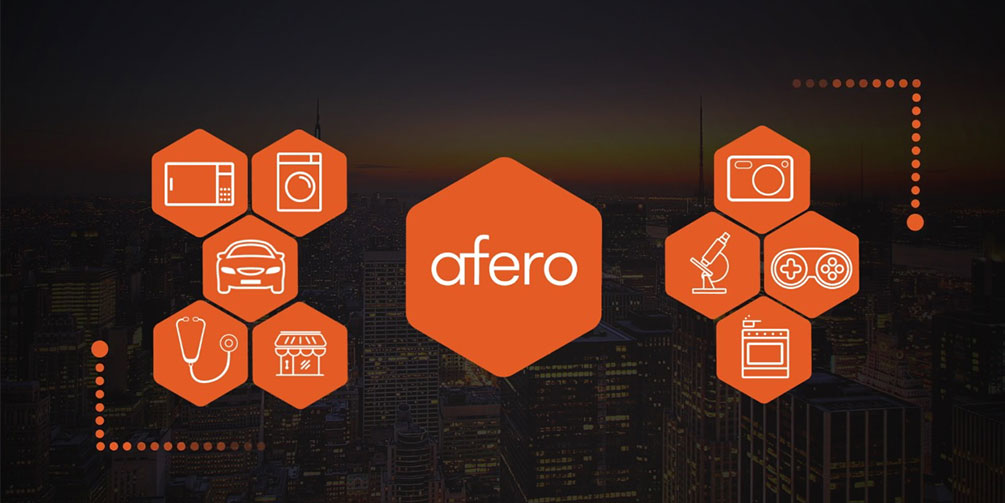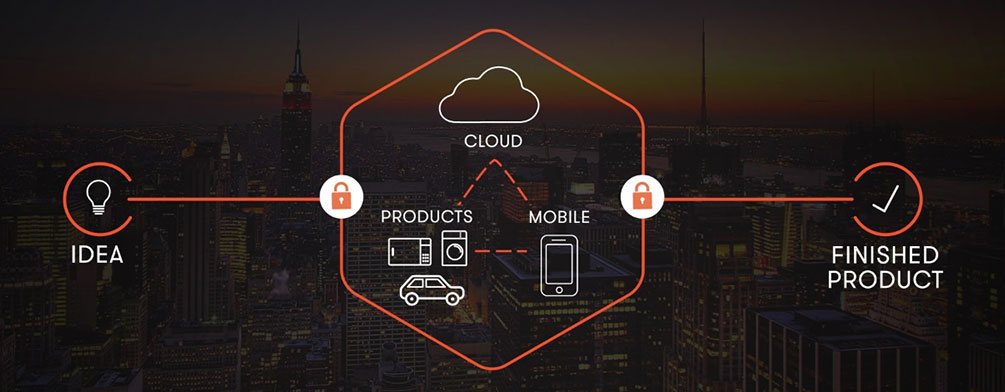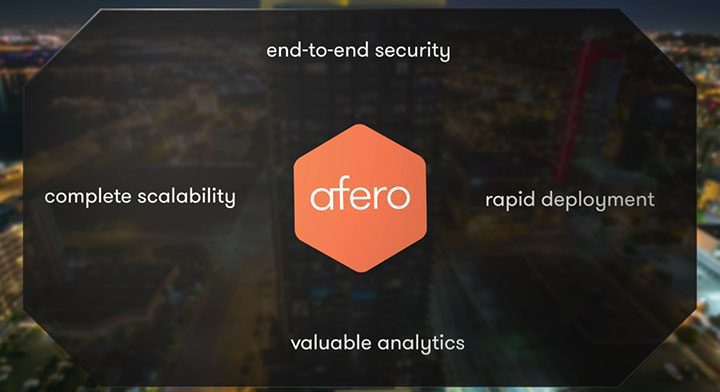Afero, the platform bringing secure connectivity to the Internet of Things for both enterprises and the home, recently completed a $20.3 million Series A financing. The investment was led by Samsung Catalyst Fund. The round also included the SoftBank Group, Fenox Venture Capital, Presidio Ventures, Sanshin Electronics Co. Ltd., Robert Dobkin, and Assembly Partners. Below is our interview with Joe Britt, CEO and co-founder of Afero:

Q: Joe, what is Afero?
A: Afero is an end-to-end secure connectivity platform for the Internet of Things, or IoT. Our technology helps companies rapidly create and deploy connected products by automating the core embedded, mobile, and cloud development tasks. We enable manufacturers to offer all kinds of devices as web-enabled peripherals. The Afero IoT platform reaches all the way from the hardware at the lowest level up to software, development tools, and the cloud, ultimately exposing a set of cloud APIs for developing cloud-connected devices.
There is a wide spectrum of devices and many different kinds of IoT products, but all of them share a common need for secure and reliable connectivity to the Internet. Afero tackles the four big challenges developing in the IoT: 1) Security, 2) Fragmentation, 3) Connectivity, and 4) Rapid Development. Using the Afero platform to build an IoT device automates many complex tasks that would normally be done manually by multiple engineering teams.
Afero was designed to speed and simplify product development, whether companies choose to modernize a legacy product or create something entirely new.
 Recommended: For The First Time Ever, IRA Owners Can Hold Actual Bitcoin In An Anonymous Securitized Wallet
Recommended: For The First Time Ever, IRA Owners Can Hold Actual Bitcoin In An Anonymous Securitized Wallet
Q: Could you tell us the Afero startup story?
A: We had started Afero in May of 2014, and began building not a platform but rather a new kind of consumer IoT device.
By July we had built a working prototype (hardware and software), but to get the security and connectivity experience just right we had needed to build a lot of infrastructure pieces ourselves. We planned to reuse that infrastructure for future products, so we had designed it in a tightly integrated but modular way. It was an investment, one that would make future product development easier and faster.
We were excited about our device concept, but found ourselves getting more excited about the framework we were building the device on. We had developed what we saw as elegant solutions for common problems that most IoT developers encounter.
That was when we realized that the Afero infrastructure was the truly remarkable part. In December of 2015 we launched the Afero IoT platform.
Q: Can you give us more insights into your solutions?
A: Afero is for all industries. Our platform allows companies to bring connected solutions to market rapidly, in and beyond the smart home. We’ve developed breakthrough solutions for common and complicated challenges that most IoT developers encounter: security, device setup, connectivity, and the inconvenient need for a hub.
Even more importantly, we’ve created tools to automate the development process so that both the developer and user communities can build connected and smart products simply and easily.
Most of the IoT industry is laser-focused on the smart home, whereas Afero is able to easily and securely connect devices for businesses looking for IoT adoption. Big differentiators for Afero are:
● Security — The Afero platform has layers of security embedded throughout the platform, from application services on your phone to network access control services with built-in authentication to the cloud and back
● Dynamic Hub — devices can automatically connect through any available hub or gateway
● Legacy / Brownfield development — Afero is designed for new and brownfield development. Just bolt the Afero ASR-1 security module onto any legacy design with minimal impact on product design
 Recommended: Fidelis Education – Leads The Learning Relationship Management (LRM) Movement
Recommended: Fidelis Education – Leads The Learning Relationship Management (LRM) Movement
Q: What are main benefits of using Afero’s solutions. How is it different than existing solutions?
A: Connected devices span a broad range of complexity. Some devices, like motion detectors, door locks, and lights are very simple. Others are very complex — devices like cars, aircraft engines, and medical equipment incorporate sophisticated hardware and software performing complicated tasks. Regardless of whether it is simple or complex, creating a connected device requires three different software development efforts to integrate harmoniously: 1) Embedded Software, 2) Mobile Software (for multiple platforms), and 3) Cloud Software.
It’s all software development, but it’s three very different kinds of software development. The hardware resources provided to each effort vary substantially, and this directly impacts the software development best practices. Getting all three software efforts to work well together can be tricky. The engineers building each of those pieces have to work hard to ensure that each piece communicates with each other piece securely, reliably, and quickly.
During the formative IoT device development months at Afero, we found that there were no tools that pulled all of the pieces together in the ways we wanted.
In studying how many existing IoT devices were constructed, we often came across the dreaded “Frankenstein” approach. Bits and pieces were lifted from each discipline and cobbled together. Compressed development schedules and limited expertise in some of the critical areas led others to compromised design performance, security, or both.
Many of the original Afero team had worked together at other connected device companies — but well before the term “IoT” was coined. Places like Catapult (X-BAND), WebTV, and Danger, known for lightweight devices imbued with capabilities beyond what their hardware could do, by virtue of a powerful cloud service. Many also came from well-known cloud companies like Twitter, Netflix, Amazon Lab126, and Google. With that experience, we thought about how we, as IoT developers, would want these core software components to work:
● Out-of-box setup (onboarding)
● Hubs / Gateways
● Device management, sharing, choreography
● Mobile integration
● Cloud APIs
● Security
We then built the tools we, as developers, wanted. We wanted Afero to handle, in the default case, all of those things as automatically as possible.
Q: You’ve recently announced a $20.3 million series A funding round; what are your plans?
A: Afero spent 18 months in stealth, thinking about the really vexing issues around IoT and how to address them. We’ve been very fortunate to build out a team whose pedigree is very appropriate for building this kind of system. The Afero team includes many folks I’ve worked with before at places like Apple, Google, WebTV, and Danger, but we also have a bunch of great folks from Amazon, Twitter, and some folks from Nest. We have a shared context that helps us understand how to tackle the challenges and design and build a system like this. This round of funding will serve as growth capital as we focus on rapidly expanding our business reach and continuing our investment in product development. We are excited about the opportunity to accelerate the development and adoption of IoT products and services.
 Recommended: CONSENSUS Raises $4.2 Million To Accelerate Its Growth
Recommended: CONSENSUS Raises $4.2 Million To Accelerate Its Growth
Q: Can you share the Afero security features?
A: Working with leading security experts, Afero went through each link in the ecosystem and identified potential security vulnerabilities. We then took best practices from the computer security world (encryption algorithms, strong mutual authentication, secure key generation and storage, chains of trust, short-lived session keys, etc.) and adapted them to the processing and memory resource disparity of the device and the cloud. Above and beyond the cryptography and key management, we also invented patent-pending technologies to obscure IoT traffic patterns to make it more difficult to use the relatively predictable behavior of some devices as an attack vector.
Afero uses a mutually authenticated Elliptic Curve Diffie-Hellman key exchange. Both the device containing embedded Afero technology and service are authenticated over the negotiation channel. Signed shared ephemera are exchanged (only public keys are transmitted over the negotiation channel so no encryption is required) and then these keys are used to generate a shared secret. The shared secret is generated independently by both the authenticator and the device, but the secret is the same on both.This secret is then used to encrypt/decrypt as well as authenticate messages (using the AES-GCM algorithm) which are sent over the messaging channel.
Afero uses 256-bit ECC (Elliptic Curve Cryptography) key pairs. These are generated by and stored securely within Hardware Security Modules (HSMs). Each Afero radio (such as the ASR-1) contain one of these HSMs. Private keys never leave the HSM.
Q: What makes Afero a good choice?
A: We want to help developers focus on the fun stuff — the differentiating features and technology that set their products and services apart. Secure and reliable connectivity is something that everyone needs, and getting it shouldn’t require reinventing the wheel.
We believe that product developers, service providers, and users will appreciate the way Afero lets the “how” of connecting to the internet fade into the background so the focus can be on the “why”.
We’ve built Afero to be accessible to a broad range of developers, from novice to expert, and invite them all to try Afero and see how it can accelerate and improve product development. Our development boards enable experimentation within minutes of unwrapping them. See for yourself and let us know what you build!



